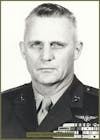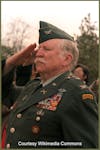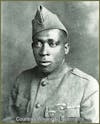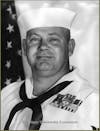US Air Force CMSGT Richard Etchberger: Vietnam War Medal of Honor Recipient
Uncover the incredible true story of Chief Master Sgt. Richard Etchberger, the Air Force's long forgotten enlisted hero. Witness his unwavering courage and selfless sacrifice during the Vietnam War's secret mission at Lima Si...
Uncover the incredible true story of Chief Master Sgt. Richard Etchberger, the Air Force's long forgotten enlisted hero. Witness his unwavering courage and selfless sacrifice during the Vietnam War's secret mission at Lima Site 85.
In this shoe, you'll discover:
- Etchberger's journey from ordinary Airman to legendary leader
- The harrowing events of the Battle of Lima Site 85
- His acts of heroism that saved countless lives
- The long road to recognition and the awarding of the Medal of Honor
This is a story of bravery, leadership, and the enduring spirit of an American hero.
Please visit our website to learn more about other American Heroes.
www.dutyandvalor.com
Sources:
wikipedia.org
defense.gov
afhistory.af.mil
nationalmuseum.af.mil
historynet.com
taskandpurpose.com
Thank you for listening to Duty & Valor!
Music by Amelie Leclerc. Artist's other music can be found here.
Please follow us on your favorite social media site.
Facebook
Instagram
Twitter
YouTube
Welcome back everyone. On today's episode of Duty & Valor, you’ll hear the story of a man who was regarded as a true leader who put those around him first. A man who volunteered for a secret mission during the Vietnam War, even though he knew it would be a dangerous one. A man who with no combat training, held off a fierce enemy attack on a steep mountain side in Laos. This is the story of Medal of Honor Recipient US Air Force Chief Master Sergeant Richard Etchberger.
Richard was born in Hamburg, PA on March 5, 1933 to parents Donald and Kathryn Etchberger. The youngest of two boys, he and his brother Bob were forced to help their family during WWII when their father lost his job after the US entered the war. The factory where their father worked could no longer acquire the silk needed to make products so it was forced to close. Unlike many younger Americans during this time, Richard worked to support his family, but remained focused on his education. At Hamburg High School he was a star basketball player, a member of the speech club, literacy society, treasurer of the library club, and the senior class president. Doing all this while still working at a department store. He graduated in 1951 and a few months later, enlisted in the US Air Force.
Following basic training at Lackland Air Force Base in San Antonio, Texas, he attended Airmen Electronic Fundamentals School and then Radar Maintenance School, both at Keesler Air Force Base in Mississippi.
He was then assigned to radar units at Hill Air Force Base in Utah, McClellan Air Force Base in CA and then back to Utah as a Staff Sergeant. It was in Utah that he met, and eventually married, Katherine Vaccaria. Sgt. Etchberger helped raise her son Steven as his own, and the two would also go on to have two boys, Richard and Cory, as well as a little girl named Loy Elizabeth who died during childbirth.
Before the start of the Vietnam War, Sgt. Etchberger saw service in Morocco, North Dakota, the Philippines, and then back stateside in Illinois. By now he was a Chief Master Sergeant and was known as one of the best in his field, as well as being regarded as a true leader. Due to his outstanding reputation, he was offered a top secret, volunteer only, assignment codenamed Project Heavy Green.
As the US was bombing targets throughout North Vietnam, the results were less than desired. The inaccurate bombing was largely due to the distance between radar and the target sights. The answer to this was to somehow get radar sights operational closer to North Vietnam.
Under the direction of the Air Force and CIA, Project Heavy Green sought to install radar sites in the mountains of Laos, close to the North Vietnamese border. This plan had to be top secret as there was a treaty signed by 14 nations, including the US and North Vietnam, that ensured Laos would remain neutral and keep the war from spreading to nearby countries.
To get around the agreement to not place US forces in Laos, all the members who joined Project Heavy Green had to resign from the Air Force and they all became civilians employed by Lockheed Martin. Etchberger and the other fifteen former airmen, two CIA agents, and one forward air controller, or combat controller, found themselves at Lima Site 85, a mountainside radar installation just 12-15 miles from North Vietnam. The distance varies based on the source.
These sites weren’t secret for long. As American bombing raids across North Vietnam grew increasingly effective, the North Vietnamese suspected there were radar installations operating close to their border. They focused their suspicions in the direction of Laos, and soon their suspicions were confirmed. Lima Site 85, and others like it, were now targeted by enemy forces.
In an effort to neutralize the site, North Vietnamese forces attacked it on January 13, 1968. They attacked the site with two biplanes, killing several US aligned guerillas. A nearby UH-1 Huey flown by Air America gave chase and was able to shoot down one of the biplanes. Air America was a passenger and cargo airline that had been secretly owned and operated by the CIA for 18 years by this time. It was reported that plans were made to abandon Lima Site 85, but it didn’t happen before the fateful night that saw it get destroyed.
The site came under attack from North Vietnamese soldiers at 6pm on March 10, 1968. The North Vietnamese fired mortars and B-40 rockets into Lima Site 85, damaging many buildings. In addition to the heavy barrage, approximately 1,000 enemy forces attacked local forces that were guarding the base of the mountain, though this attack was unknown to the men 4,500 feet above. The altitude of the location gave the Americans a sense of security as it wasn’t believed enemy forces could scale the surrounding cliffs and assault the site. That’s also why most of the men assigned to the radar site had little, to no, combat training. The only one with true combat training was the Air Force Special Ops Combat Controller, Sgt. Roger Huffman.
Etchberger and the other men, who were off duty at the time, had to sleep outside as their quarters were destroyed by the mortar and rocket fire. They carried their M-16’s and survival radios to the cliff side south of the radar buildings, where they planned to sleep.
At 2AM the next morning, 26 North Vietnamese sappers proved to the Americans that it was possible to assault the site located on a steep hillside. They swept through the buildings and attacked and killed all of the men that they encountered. By 3AM only eight of the nineteen men were still alive.
Etchberger and the other men with him moved to protection under a rock overhang and hadn’t been there ten minutes before they saw a dozen enemy soldiers heading their way. As they approached their position, Etchberger took aim and fired at them with his M-16. The enemy responded with their own gunfire and grenade attacks.
While Sgt. Huffman directed airstrikes dangerously close to their positions, Etchberger and the other men fought back hard. But soon the only one able to fire his weapon was Etchberger, as he was the only one not injured. He was one of the men that had little, or no combat training, so it was remarkable that he was able to hold off the attackers. Over the next five hours Etchberger alternated between treating his injured friends and firing at the nearby enemy, but by 7:30AM, only three men were still believed to still be alive. Etchberger, Stan Sliz and John Daniel.
With an early morning fog blanketing the area, an Air America Huey flown by Ken Wood, a former Army Captain, surveyed the area. He spotted the three men on the side of the cliff and positioned the helicopter for the men’s extraction. Luckily the same heavy fog concealed the rescue mission. Once in position, the helicopter lowered a hoist seat to the men. Etchberger helped get the semi-conscious Daniel into the seat and they pulled him up. After the seat returned, he then helped Sliz onto it and he saw his friend pulled up to safety.
When the seat was lowered a third time, Etchberger got onto it and was about to be raised when another man, who wasn’t known to still be alive, raced towards him. Bill Husband, a diesel mechanic had escaped the initial assault and hid in the nearby brush. There was no way Etchberger was going to leave the other man behind for another moment. He put the man in a tight bear hug and they were raised toward the helicopter. But before the men reached the helicopter, the Huey received direct hits from ground fire, forcing Wood to quickly maneuver away from the cliffside. The maneuver was described as violent, so it was amazing that both men were able to be pulled into the helicopter.
As soon as he made it aboard, Etchberger, who was seated, was hit when an armor piercing round hit the underside of the helicopter, passed through it, and hit his lower body.
They flew to Lima Site 36, which was 30 minutes away. As soon as they landed, the survivors were loaded onto another Air America aircraft, this time a C-123 heading to Udorn Air Base in Thailand, as there were no medical personnel at this site. There were also no medical personnel on the flight, so the best they could do for the injured was to keep them comfortable. By the time the plane landed at Udorn, Etchberger had died of his wounds.
While the injured men were being flown to Thailand, another Huey was able to extract Sgt. Huffman and Woody Spence, one of the two CIA case officers.
For his selfless heroics at Lima Site 85, CMSGT Richard Etchberger was nominated for the Medal of Honor, but due to the secret nature of the site, it was decided that he could not be awarded the medal. He was however awarded the Air Force Cross at a secret ceremony at the Pentagon, but the award was never documented on his official record for the same reason.
Eventually the existence of the Lima Sites were declassified, leading to his recommendation gaining traction, but it would still take years before he was honored by his Nation.
At a White House ceremony on September 21, 2010 President Obama presented CMSGT Richard Etchberger’s Medal of Honor to his family.
Following his death, CMSGT Etchberger’s body was returned home and he was buried at the St. John’s Cemetery in Hamburg, PA.
Chief Master Sergeant Richard Etchberger's legacy embodies the essence of courage, sacrifice, and unwavering devotion to duty. In the face of unimaginable danger, he exemplified the true spirit of heroism, putting the safety of his fellow airmen above his own. Through his unbending spirit and unwavering commitment to his comrades, Etchberger leaves an enduring legacy that continues to inspire generations to strive for excellence and to stand tall in the face of adversity.
Thank you for listening to this episode of Duty & Valor. To read more about this week’s hero, check out the sources used in today's episode in our show notes and at dutyandvalor.com.
If you want to listen to our episodes early, we release new episodes on our YouTube channel of the same name on Fridays at 5pm. Also, on our channel we release daily YouTube shorts that highlight our Nation’s heroes, most of whom haven’t been featured on the show yet.
Be sure to like, follow, and share our episodes and please join us for our next episode, where we'll be sharing the inspiring story of another American hero who served with pride and lived with humility.




















